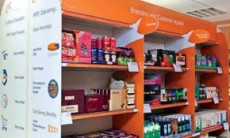Corrugated giant eyes retail-ready boom
Josh Brooks, Packaging News, 01 July 2009
Corrugated packaging has moved out of the supply chain shadows into a leading role on the main stage - the supermarket shelf. Josh Brooks visits DS Smith's new Impact & Innovation centre to find out more

Ask anyone outside the industry to describe corrugated packaging, and the chances are high that they would conjure up images of brown cardboard boxes. They might mention the last time they moved house. Or perhaps bemoan the fact that those boxes are no longer given away at supermarket tills.
Of course, none of this is wrong. But it only tells half the story, because corrugated packaging is making an impact on the supermarket shelf. Where once, brown boxes were a stalwart of the supermarket back-of-store, their modern cousins are a key element in the marketing mix. Retail-ready packaging - or RRP - has arrived.
And, if DS Smith Packaging (DSSP) has anything to do with it, it is here to stay. To drive the point home, the UK's biggest corrugated manufacturer has just opened a dedicated centre to extol the virtues of on-shelf corrugated boxes and to convince retailers and brands that RRP can make products stand out as well as reduce cost and environmental impact throughout the supply chain.
DSSP's Impact & Innovation Centre in Ely opened last autumn and is already attracting some top brands. The concept is simple: a supermarket and back-of-store environment have been built, where packaging specifiers and buyers can spend time developing how best to use RRP to sell more products.
Changing attitudes
DS Smith director of market development Terry Morgan, who is responsible for setting up the centre, says its construction has reflected the changing view of retailers towards packaging. "A few years ago, corrugated was a brown box business. Things like range blindness and consumer usability weren't an issue five years ago. There's been an extraordinary change," he says.
RRP is now a key growth area for DSSP - Morgan estimates that 65-70% of the group's production ends up in supermarkets, an increasing proportion of which is shelf-loving RRP. Morgan says: "What we did well was to get hold of it quickly and really go for it."
That change is highlighted in the first area of the IIC, which is attached to the 3D display graphics site that is part of DSSP's Multigraphics division. Rows of supermarket shelves, cooler cabinets and freezer units are packed with both good and bad examples of RRP, be they on-shelf or more elaborate point-of-sale displays. The effect is completed with a background soundtrack of supermarket sounds.
Boosting brands
The area aims to demonstrate opportunities RRP can present. RRP packs increasingly carry full-colour images designed to play as key a role as the primary packaging in the final sell to consumers. They avoid having to stack individual items on shelves, allowing far quicker replenishment and potentially higher sales for the brand and store. Yet badly done retail-ready packs can kill a brand, and the IIC has plenty of examples where it all went wrong.
And while RRP is currently primarily used for ambient, or room-temperature, products, Becky Tompkins, DSSP marketing manager, who runs the IIC, says the format is likely to grow. "We expect retailers to continue it into freezer units, and there's a great opportunity for branding fresh produce," she says.
But it is through a set of supermarket-style swing doors, and into a back-of-store area, that RRP's other great sales story - time and money savings - comes into its own. The area features pallets, cages, huge stock shelves and even the back end of a fake lorry parked in a simulated loading area.
Here, visitors are taken through how pallets can be most efficiently used to reduce the numbers of lorries on the roads; how merchandising units can be designed and optimised for both distribution and in-store; how printed RRP makes it easier to identify products in the back-of-store area; and the recycling credentials of corrugated board.
A third and final area of the IIC gives clients the chance to sit and work out what they might actually do with their packaging. DS Smith has developed PackRight, a software package covering design and business aspects of packaging, and here visitors can play with the software to come up with the best possible answer to their particular problem.
Of course, the centre exists to sell RRP and corrugated. Yet it does seem to be getting a strong message across. Morgan says that groups at the IIC are often from different areas of the clients' business - for instance, brand management, board-level directors and logistics manager as well as packaging teams. "When they see the kind of cost, environmental or marketing implications of what we're talking about, they sometimes ask us to leave the room," he says. "Reactions can be quite heated."
Heated, perhaps. Maybe that's because a lot of people still think of corrugated packaging as brown cardboard boxes.
